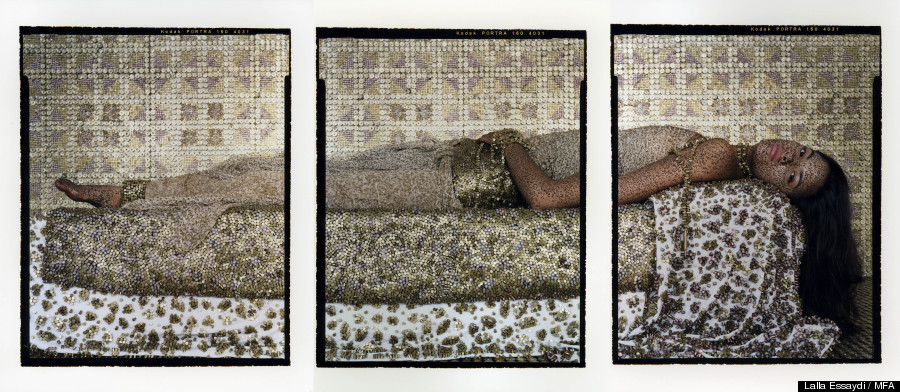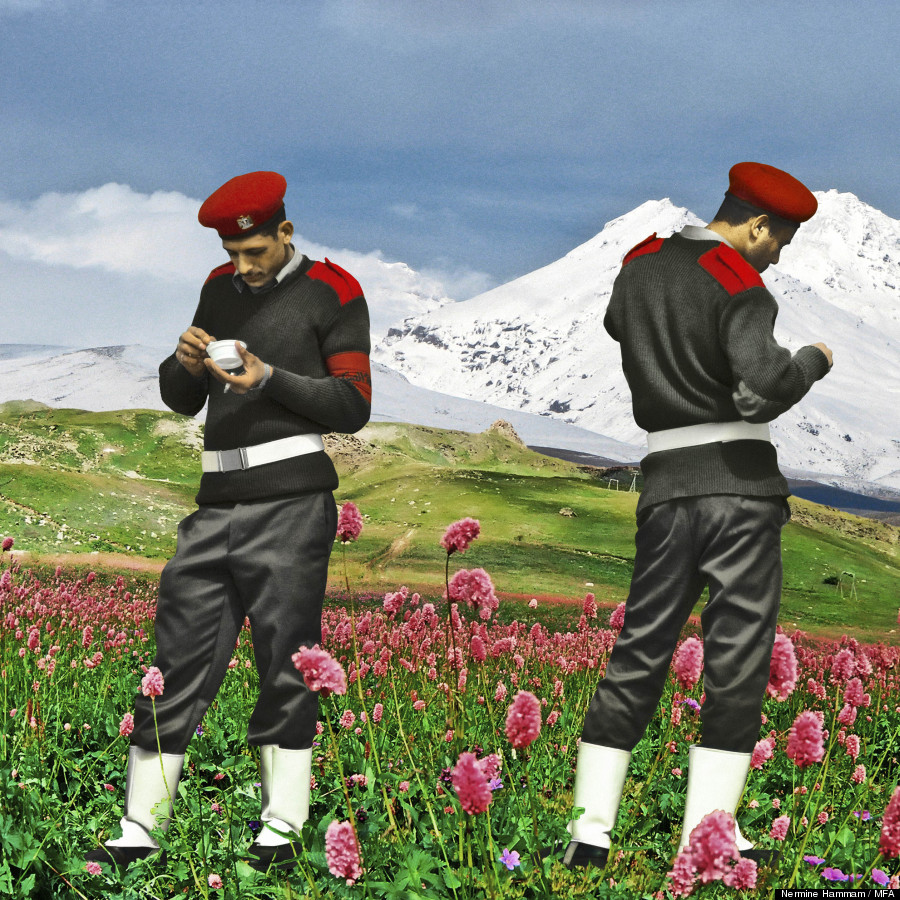BOSTON (RNS) An Iraqi woman dons a black hijab but bares her thighs. A Lebanese woman wearing a sheer blouse curls up on a bed, both innocent and seductive. An attractive young Iranian couple shares breakfast at a small table, seemingly oblivious to the tank looming just a few yards away.
There are no harems, belly dancers, or male oppressors in this photography show, nor any of the other Middle Eastern stereotypes that Westerners generally associate with that far away, often misunderstood, region.
![car]()
Untitled, from the Women of Gaza series
Tanya Habjouqa (Jordanian, born in 1975) 2009
Pigment print
*© Tanya Habjouqa
*Museum purchase with general funds and the Horace W. Goldsmith Fund for Photography *Courtesy, Museum of Fine Arts, Boston
“She Who Tells a Story,” a photo exhibit now showing at Boston’s Museum of Fine Arts and headed to other U.S. museums, features the work of 12 women from the Middle East who shatter stereotypes with works that are provocative, beautiful, mysterious, and surprising, all at the same time.
Giacomo Voorhees, who serves in the Navy in San Diego but was recently in Boston where he grew up, saw the exhibit with his grandparents.
“I think we generalize about women there being oppressed and not having a voice, but these photos show that’s not exactly always true,” he said.
![dont forget]()
Don’t Forget This Is Not You (for Sahar Lotfi)
Newsha Tavakolian (Iranian, born in 1981) 2010
Pigment print
*Reproduced with permission.
*Courtesy of the artist and East Wing Contemporary Gallery. *Courtesy Museum of Fine Arts, Boston.
Exhibit curator Kristen Gresh thought the same thing, and drew on her experience of living in Paris, home to many Middle Eastern immigrants, and Cairo.
“My main goal was to showcase the contemporary artistic scene, and breaking down stereotypes turned out to be a byproduct,” she said.
Shirin Neshat, who was born in Iran but lives in New York, shot close-ups of a woman’s face, her mouth closed and covered by her hand. Silenced? No. The hands are adorned with lines written in Farsi and taken from books by contemporary female Iranian authors.
In one of the show’s most haunting images, Lalla Essaydi, a Moroccan native who spent part of her childhood in Saudi Arabia, and now lives in New York City, presents a three-paneled photo of a woman with a flowing black mane decked out in henna and a glittering gold dress lying on a divan. On closer inspection, however, the woman is covered in hospital gauze; the glitter is not gold but bullet shell casings.
![bullets]()
Bullets Revisited #3
Lalla Essaydi (Moroccan, born in 1956) 2012
Triptych, three chromogenic prints on aluminum
*Reproduced with permission.
*Courtesy of Miller Yezerski Gallery Boston; Edwynn Houk Gallery New York *Courtesy Museum of Fine Arts, Boston.
“Like any woman in the world, Arab women certainly have specific difficulties that they face,” said Essaydi, who explained that her triptych refers to the role that Arab women played during the Arab Spring. “But they are not debilitating. Arab women are not universally oppressed, subjugated, or depressed. Their lives are no more to be defined by stereotypes than anyone else’s.”
Rania Matar, who was born in Lebanon and now lives in Brookline, Mass., said she wanted to show the “humanity and universality of being a woman” through her series “A Girl and Her Room,” which depicts teenage girls in their bedrooms in the U.S., Lebanon and the Palestinian territories.
“All the news is about how different they were,” said Matar. “But at the core, they are the same — the emotions and feelings they deal with, what they react to, how they grow. There are things that are universal about girls.”
![alia]()
Alia, Beirut, Lebanon
Rania Matar (Lebanese, born in 1964) 2010
Pigment Print
*© Rania Matar.
*Courtesy of the artist and Carroll and Sons, Boston. *Courtesy Museum of Fine Arts, Boston.
Part of what inspired Matar to become a photographer was the way the media depicted the region as a cultural and religious monolith rife with violence and extremism.
“It’s too simplistic to lump people all into one category,” said Matar, who was born into a Palestinian Christian family. “But it happens so often that I get almost defensive and feel I have to do something to correct these mistakes.”
While not religious, Matar still takes exception to the description of the Middle East as the “Islamic world.” Christians, Jews, and people of other faiths live in that part of the world.
Although many of the photos undermine stereotypes, others offer criticism of society or government.
Gohar Dashti’s series, “Today’s Life and War,” depicts Iranians going about their daily lives as the Iran-Iraq War rages in the background. The absurdist photos depict newlyweds sitting in a bombed-out car, the handsome young couple hanging their laundry on barbed wire and watching television in a room where the walls are made from sandbags.
![gohar]()
Untitled #5
Gohar Dashti (Iranian, born in 1980) 2008
Pigment print
*Reproduced with permission.
*Courtesy Galerie WHITE PROJECT Paris. *Courtesy Museum of Fine Arts, Boston.
“When the horrific nature of war becomes normal, it takes a surreal form,” said Dashti, who grew up during the war in a city close to the Iranian-Iraqi border. As for criticism, she said, “Normally any government does not like this, however I’m not an activist. I’m only an artist.”
The photos are so beautiful and technically masterful, it seems unfortunate that they deal with complicated and often difficult realities. But many of the women wouldn‘t have it any other way.
“Beautiful art with no means, no substance will become merely decorative,” said Essaydi. “If it is not identity issues, we would have researched other issues.”
Matar agreed. “Beauty needs thought. And thought needs beauty,” she said. “The two need each other.”
![men]()
The Break
Nermine Hammam (born in 1967) 2011
Pigment print
*© Nermine Hammam
*Courtesy of the artist, Rose Issa Projects, London, and Taymour Grahne. *Courtesy Museum of Fine Arts, Boston.
(“She Who Tells a Story” closes in Boston on Jan. 12. The show will travel to other museums including the Cantor Center for Visual Arts at Stanford University in January 2015.)
There are no harems, belly dancers, or male oppressors in this photography show, nor any of the other Middle Eastern stereotypes that Westerners generally associate with that far away, often misunderstood, region.

Untitled, from the Women of Gaza series
Tanya Habjouqa (Jordanian, born in 1975) 2009
Pigment print
*© Tanya Habjouqa
*Museum purchase with general funds and the Horace W. Goldsmith Fund for Photography *Courtesy, Museum of Fine Arts, Boston
“She Who Tells a Story,” a photo exhibit now showing at Boston’s Museum of Fine Arts and headed to other U.S. museums, features the work of 12 women from the Middle East who shatter stereotypes with works that are provocative, beautiful, mysterious, and surprising, all at the same time.
Giacomo Voorhees, who serves in the Navy in San Diego but was recently in Boston where he grew up, saw the exhibit with his grandparents.
“I think we generalize about women there being oppressed and not having a voice, but these photos show that’s not exactly always true,” he said.

Don’t Forget This Is Not You (for Sahar Lotfi)
Newsha Tavakolian (Iranian, born in 1981) 2010
Pigment print
*Reproduced with permission.
*Courtesy of the artist and East Wing Contemporary Gallery. *Courtesy Museum of Fine Arts, Boston.
Exhibit curator Kristen Gresh thought the same thing, and drew on her experience of living in Paris, home to many Middle Eastern immigrants, and Cairo.
“My main goal was to showcase the contemporary artistic scene, and breaking down stereotypes turned out to be a byproduct,” she said.
Shirin Neshat, who was born in Iran but lives in New York, shot close-ups of a woman’s face, her mouth closed and covered by her hand. Silenced? No. The hands are adorned with lines written in Farsi and taken from books by contemporary female Iranian authors.
In one of the show’s most haunting images, Lalla Essaydi, a Moroccan native who spent part of her childhood in Saudi Arabia, and now lives in New York City, presents a three-paneled photo of a woman with a flowing black mane decked out in henna and a glittering gold dress lying on a divan. On closer inspection, however, the woman is covered in hospital gauze; the glitter is not gold but bullet shell casings.

Bullets Revisited #3
Lalla Essaydi (Moroccan, born in 1956) 2012
Triptych, three chromogenic prints on aluminum
*Reproduced with permission.
*Courtesy of Miller Yezerski Gallery Boston; Edwynn Houk Gallery New York *Courtesy Museum of Fine Arts, Boston.
“Like any woman in the world, Arab women certainly have specific difficulties that they face,” said Essaydi, who explained that her triptych refers to the role that Arab women played during the Arab Spring. “But they are not debilitating. Arab women are not universally oppressed, subjugated, or depressed. Their lives are no more to be defined by stereotypes than anyone else’s.”
Rania Matar, who was born in Lebanon and now lives in Brookline, Mass., said she wanted to show the “humanity and universality of being a woman” through her series “A Girl and Her Room,” which depicts teenage girls in their bedrooms in the U.S., Lebanon and the Palestinian territories.
“All the news is about how different they were,” said Matar. “But at the core, they are the same — the emotions and feelings they deal with, what they react to, how they grow. There are things that are universal about girls.”

Alia, Beirut, Lebanon
Rania Matar (Lebanese, born in 1964) 2010
Pigment Print
*© Rania Matar.
*Courtesy of the artist and Carroll and Sons, Boston. *Courtesy Museum of Fine Arts, Boston.
Part of what inspired Matar to become a photographer was the way the media depicted the region as a cultural and religious monolith rife with violence and extremism.
“It’s too simplistic to lump people all into one category,” said Matar, who was born into a Palestinian Christian family. “But it happens so often that I get almost defensive and feel I have to do something to correct these mistakes.”
While not religious, Matar still takes exception to the description of the Middle East as the “Islamic world.” Christians, Jews, and people of other faiths live in that part of the world.
Although many of the photos undermine stereotypes, others offer criticism of society or government.
Gohar Dashti’s series, “Today’s Life and War,” depicts Iranians going about their daily lives as the Iran-Iraq War rages in the background. The absurdist photos depict newlyweds sitting in a bombed-out car, the handsome young couple hanging their laundry on barbed wire and watching television in a room where the walls are made from sandbags.

Untitled #5
Gohar Dashti (Iranian, born in 1980) 2008
Pigment print
*Reproduced with permission.
*Courtesy Galerie WHITE PROJECT Paris. *Courtesy Museum of Fine Arts, Boston.
“When the horrific nature of war becomes normal, it takes a surreal form,” said Dashti, who grew up during the war in a city close to the Iranian-Iraqi border. As for criticism, she said, “Normally any government does not like this, however I’m not an activist. I’m only an artist.”
The photos are so beautiful and technically masterful, it seems unfortunate that they deal with complicated and often difficult realities. But many of the women wouldn‘t have it any other way.
“Beautiful art with no means, no substance will become merely decorative,” said Essaydi. “If it is not identity issues, we would have researched other issues.”
Matar agreed. “Beauty needs thought. And thought needs beauty,” she said. “The two need each other.”

The Break
Nermine Hammam (born in 1967) 2011
Pigment print
*© Nermine Hammam
*Courtesy of the artist, Rose Issa Projects, London, and Taymour Grahne. *Courtesy Museum of Fine Arts, Boston.
(“She Who Tells a Story” closes in Boston on Jan. 12. The show will travel to other museums including the Cantor Center for Visual Arts at Stanford University in January 2015.)